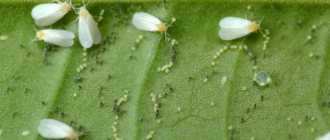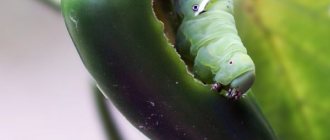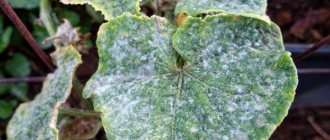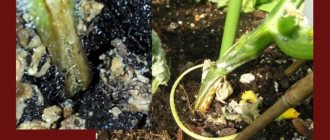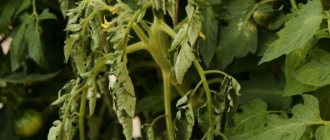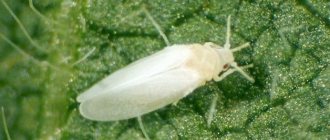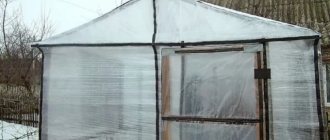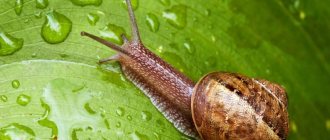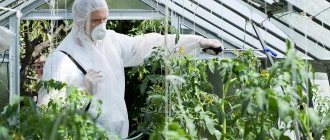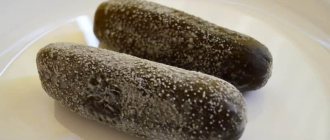Measures to prevent the appearance of aphids on seedlings
To prevent aphids from appearing on seedlings, before planting, you need to carry out preventive treatments of indoor plants and window sills with Fitoverm (2 ml per 1 liter of water), and also disinfect the soil and containers.
Regular inspections of plants and the creation of optimal conditions for the development of seedlings: temperature, watering and location will help to avoid the rapid spread of the pest.
So, it is necessary to maintain the daytime temperature at 20-25°C, and the night temperature at 16-20°C. Watering should be regular and only with settled water at room temperature. Containers with seedlings should be placed at a distance from each other so that the leaves of the plants do not touch.
You can also hang sticky insect traps that will “catch” all uninvited guests, including flying aphids.
As you can see, fighting aphids on seedlings is not easy, but it is possible. However, it is better to prevent its occurrence.
Prevention
Pathogens and pest larvae are everywhere. They are brought from the street on shoes and clothes, and pet fur. The room is heated and activated. But they affect some plants and bypass others.
The best preventive measures against the appearance of pests or diseases are cleanliness and proper agricultural practices. We must not forget about preventive treatments. Each experienced gardener has his own scheme; for beginners, we can recommend the following:
- as soon as 1-2 true leaves appear on the seedlings, they are treated with Previkur - this will prevent rot and other diseases;
- at the stage of 3-5 leaves, tomatoes are sprayed with Confidor to protect them from pests;
- immediately before planting seedlings, use the fungicide Redamil Gold.
If the substrate is accidentally poured, without waiting for problems, sprinkle the surface with dry ash. It is useful to place a crushed clove of garlic next to the containers. This will repel some pests and improve indoor air quality. To increase the tomatoes' own immunity, they are sprayed alternately with Epin and Zircon every 10 days.
It is easier to prevent the appearance of pests and diseases than to treat the seedlings later. The most important factor in the health of tomatoes is high-quality seeds and substrate. They are often the source of infection. And correct agricultural technology and preventive treatments will help to avoid problems after transplanting tomatoes to a permanent place and get a full-fledged harvest.
Prevention and pest control
Preventive measures can reduce insect populations or eliminate them completely. For this purpose, the following work is carried out:
- Autumn deep plowing of the ground, which allows the cold to destroy insects and larvae in the ground.
- Adding insecticides to the soil before plowing.
- Planting flowers, shrubs and vegetables next to tomatoes that repel pests.
- Disinfection of seeds with a solution of potassium permanganate.
- Calcination of soil for seedlings.
- Washing green tomatoes with a hose.
- Steaming the soil in a greenhouse, treating it with Bordeaux mixture.
- Attracting birds and beneficial insects to gardens.
- Removing and burning last year's tops and tomato roots.
- Location of tomato beds away from other nightshade crops.
Pest control methods depend on the type and number of insects and mites. All methods can be divided into chemical, biochemical and folk.
Chemicals destroy pests immediately after spraying the bushes. After processing, vegetables cannot be eaten for a long time - from 10 to 21 days.
Biological products act more slowly, the death of insects and larvae occurs 3-5 days after spraying. But vegetables can be eaten after 5-7 days.
Folk remedies, including mainly herbal infusions and decoctions, are harmless to people. After using them, tomatoes can be washed and eaten immediately. The disadvantage of folk remedies is the need for their frequent use.
https://youtube.com/watch?v=NPcqYrcLZag
Caring for planted tomatoes
Subsequent care for planted tomato seedlings consists of the following agrotechnical techniques:
- After planting young plants, you need to thoroughly water the soil, laying mulch on it in the root zone of the tomatoes with a layer of at least 15 cm.
- After 7-10 days, future tomato bushes should be tied to stakes or a wire system stretched in the upper part of the greenhouse.
- Having tied up the plants, carry out the first fertilizing with liquid mullein (0.5 solution per 8 liters of water) or nitrogen-containing fertilizer (15g of nitrate or 15g of nitroammophosphate per 10 liters of water). Add 0.5 liters of diluted fertilizer under each root.
- Strictly maintain the temperature regime: during the day the air temperature should not exceed +35 degrees, at night - +16.
- To avoid creating a favorable environment for the proliferation of pathogens, timely ventilate the greenhouse.
- As the tomato bush grows, you should remove all lateral shoots, growing plants in 1-2 stems.
- To better ventilate the plants, you should periodically tear off all the lower leaves.
- Tomato plants should be fertilized every two weeks, alternating root and foliar.
- During the entire period of growing tomatoes in a greenhouse, take preventive measures to prevent diseases and attacks by insect pests.
Worth knowing!
In order to obtain environmentally friendly vegetables, you should not apply mineral fertilizers. You can easily prepare organic fertilizer. To prepare it, add 500 g of crackers or bread, 200 g of nettle, 200 g of dandelion to 10 liters of water. Keep the infusion in a warm place for 2-3 days, add 500 ml under each root.
Bugs and ticks
Tomatoes are damaged by stink bugs, cucumber beetles and horse flies. These insects eat almost all garden crops. Tomatoes are also threatened by rust and spider mites.
Stink bugs
Stink bugs damage tomato fruits. Yellow and whitish spots appear on the skin of the tomato. When they are opened, white porous cells are found. Tomato bushes growing close to weeds are most often affected. The shield bug is destroyed with the drugs Aktara, Karbafos, Phosfamide, Chlorophos.
Rust mite
The rust mite is very small, the length of an adult is 0.16-0.25 mm. This pest lives in dry and hot regions of Europe and is gradually spreading to the west. The mite lives on and inside leaves, as well as in fruits. The foliage and stems of plants become spotted, brown, gray-violet. The leaves curl and die. Dense, cork-like growths appear on the fruits, which makes the tomatoes inedible.
Only timely treatment with chemicals helps against rust mites. The most effective are Vertimik and Atellik. Fufanon, Karbofos, Fitoverm, Kemifos also help.
Spider mite
Spider mites feed on the juices of the above-ground parts of the tomato. It is not difficult to notice this pest - white and yellowish dots appear on the back of the leaves. These are puncture sites. Later, the plants are entwined with a thick white web. The tick itself is very small and difficult to see.
This tomato pest loves high humidity and warm air, so it multiplies more actively in greenhouses than in open beds. Various methods are used to combat ticks. Small plantings can be sprayed with alcohol, a water tincture of henbane with soap solution, tincture of dandelion, horseradish roots, tobacco and garlic. Of the chemicals, Carbophosphorus and Agrovertin, and the drug Antiklesch are effective.
Natural enemies of spider mites are lacewings, Phytoseiulus and Metaseiulus insects. They quickly destroy the entire tick population. Insects can be purchased at nurseries.
https://youtube.com/watch?v=znIcAty6u7Q
What insects can live on a plant?
Tomato seedlings are often attacked:
- whitefly – a white butterfly 5-7 mm, its larvae eat foliage;
- thrips - small insects with wings and their larvae;
- spider mite - it is very small in size, usually only the web is visible;
- white enchytraeus (pot worm) is sometimes introduced with purchased soil.
Pests often enter seedlings from indoor plants, through contaminated soil, and there are cases of infection from cut bouquets of flowers from a greenhouse.
When growing seedlings in greenhouses, the enemies of the seedlings can be :
- mole cricket;
- wireworm;
- Colorado beetle.
Cutworm
The fight against dangerous tomato pests begins in early spring when preparing the soil for seedlings.
Caterpillars are common pests. The cutworm affects tomato leaves, but it rarely gets to the roots. Gradually the plant turns into a “sieve” and the bush withers. Once inside the stem, the cutworm completely destroys the seedlings.
The cutworm grows up to 3 cm in length. The first generation of caterpillars develops on weeds, so they get rid of them first. The larvae reproduce quickly and survive even in unfavorable conditions.
Pest control
In cases of the spread of caterpillar larvae, the use of insecticides is necessary.
Dry leaves should be sprayed at ambient temperatures below 20°C. For spraying seedlings, “Arrivo” or “Decis” is useful - a commercial insecticide that is safe for humans.
Folk remedies will help get rid of the dangerous caterpillar: to prepare a homemade solution you will need grated dry soap, flowering wormwood and wood ash. All components of the product are thoroughly mixed and 10 liters of clean boiling water is poured. The mixture should sit for at least 6-10 hours. The prepared product can be sprayed on all seedlings of tomatoes and neighboring crops.
Aphid
Photo "Aphids"
Aphids are small insects, green or black, that form large colonies (see photo). They are mainly located on the underside of the leaves, multiply quickly and cause serious damage, and sometimes death, to the tomato bush. Insects feed on the juice of tomatoes, which they suck from flowers and leaves. The female aphid has wings, she easily flies to other plants thanks to the blowing wind and lays eggs in a new place. The surest sign of an aphid is an ant; it feeds on the secretions of this insect. Before winter, ants bring aphids into their anthills, where they quietly overwinter. If you have anthills in your garden, then you need to fight them. You can fight with the help of such drugs as: Actellik, Fitoverm, Fury, Karate, Confidor. You can also use the advice of gardeners. An effective way is to plant a plant with a smell that aphids do not like: mint, fennel, coriander, garlic. An infusion of onion peels, a mixture of tobacco, ash and red pepper, is also used.
Ways to fight:
To combat small pests, they resort to treating tomato bushes with insecticides: Akarin, Tomato Rescuer, Decis pro, Proteus, Ratibor, Confidor maxi. Treatment should be carried out in dry, warm weather according to the instructions.
Seedling diseases, their prevention and control measures
Often, summer residents who set up a “window garden” in winter are faced with a number of seedling diseases and give up, throwing out “unsuccessful” seedlings. However, if the seedlings get sick regularly, you still need to know the symptoms of the diseases, since this will help save healthy plants that are located on the same windowsill next door.
Damping off
Damping off occurs when the growing conditions of plants are incorrect or in cases where you did not manage to remove the cover from them in time. The plant finds itself in an oxygen-free environment and literally begins to suffocate.
When dampened, up to 80-95% of seeds do not germinate
Symptoms: most of the seeds do not germinate, and the sprouts decompose directly in the ground.
Reasons: seeds and seedlings are too buried in the ground. As a result of non-compliance with the temperature regime, plants are too often in a waterlogged state, which weakens them and makes them susceptible to infection by fungus.
Control measures: reduce the frequency of watering by half and create a favorable microclimate for plants (temperature about 18-20°C, humidity 60-70%). Treat the soil with Fitosporin-M or a dark solution of potassium permanganate.
Root rot
Root rot is a very serious fungal disease. If you do not detect it in a timely manner and do not take measures to save the plants, it can destroy all the seedlings in the shortest possible time.
Root rot is sometimes confused with blackleg, although the former is characterized by yellowing of the leaves
Symptoms: cotyledon leaves turn yellow and turn pale, a brown coating forms on the root collar, the stem turns black, rots and becomes thinner. A constriction appears at the base, separating the affected part from the healthy part.
Causes: pathogens can be introduced with soil or seeds. The disease is provoked by untimely picking, poor lighting, high humidity and high air temperature, thickened sowing, and high soil acidity. Excessive growth and stretching of seedlings also weakens its resistance to root rot.
Control measures: first of all, remove the diseased plant along with a lump of earth and add peat in its place. Water unaffected seedlings with warm water and regularly disinfect the soil using the preparations Healthy Earth, Fundazol, etc.
Withering
The causative agent of this process is a soil fungus, which can exist in the soil for a very long time, causing chronic diseases of the plants in it.
Often, wilting is also a consequence of insufficient watering.
Symptoms: first, the tops of the shoots wilt, and then the leaves become variegated, and the plant gradually withers. Subsequently it dries, sometimes very quickly, sometimes more slowly.
Reasons: soil contamination by pathogenic microorganisms, air temperature 15-20°C and low humidity.
Control measures: when picking seedlings, treat the soil with a solution of biological products (Trichodermin, Planriza, etc.). Remove the damaged plants along with a lump of earth, and pour a fungicide solution (Fitosporin-M or its equivalent) into the empty holes.
Blackleg
One of the most dangerous and intractable plant diseases. When infected with blackleg, as a rule, all seedlings die, and it is almost impossible to stop this process.
The black leg is capable of destroying all crops not only in the apartment, but also subsequently on the site
Symptoms: sprouts wither, the above-ground part of the stems becomes thinner, turns black, and eventually dies.
Causes: the disease is transmitted through contaminated soil, and its aggravating factors are high temperature and waterlogged soil. Crops may die within 24 hours.
Control measures: it is easier to prevent the appearance of a black leg than to cure it. Always disinfect the soil before sowing seeds, monitor the temperature and humidity in the room, after watering, cover the ground with dry sand and loosen the soil more often. Remove diseased plants in a timely manner; sprinkle the area where they grew with wood ash. Cover the entire surface of the soil with a 1-1.5 cm layer of oven-baked and cooled river sand.
White and yellow stripes on tomato fruits, purple leaves and stems
The fruits are woody and tasteless, covered inside with a white network of vessels. The leaves are curled, have an unnatural color, and become smaller over time. Stamens and pistils in flowers are underdeveloped. The roots are covered with cracks. The plant is stunted in growth.
Diagnosis: mycoplasmosis, or stolbur, of tomatoes is an infectious disease caused by mycoplasmas, tiny bacteria that live in the vessels of plants.
Stolbur most often affects plants in open ground. The peak of the disease usually occurs at the end of August. The disease is carried by sucking insects, in particular the leafhopper (slobbering frog), a dangerous garden pest. The risk of infection with stolbur increases in hot and dry weather, when insects actively reproduce. The infection can also enter the soil through infected seeds and seedlings.
Control measures. Infected bushes need to be dug up, because... they cannot be treated. To prevent re-infestation, weeds must be controlled. You can also spray plantings against leafhoppers using Kinmiks or Tsvetofos. Dusting plants with wood ash (30 g per bush) will also help.
Prevention of tomato diseases
Timely preventive measures will help you protect plants from pathogens:
- plant disease-resistant tomato varieties;
- before sowing seeds for seedlings, treat them with Fitolavin, Fundazol, Strekar or TMTD;
- disinfect garden tools;
- disinfect the soil with Trichodermin, Fitosporin and other chemicals; a solution of potassium permanganate is also suitable;
- discard weak and diseased plants;
- observe crop rotation;
- increase plant immunity with a double dose of potassium fertilizers;
- follow the watering and fertilizing regime;
- regulate the temperature and humidity in the greenhouse (the norm is no higher than 32°C and 80%);
- destroy pests and weed;
- Clean the greenhouse at the end of the season, remove plant debris and dig up the soil.
To ensure that the tomato harvest increases every year, monitor the health of the plants and take timely measures to combat major diseases. Also read about how to identify and treat diseases of cucumbers, peppers and zucchini.
Rotten
Rotting of tomato sprouts occurs from too low ambient temperatures or from excessive watering. The first sign of the disease is a change in the color of the leaves of the seedlings. Later, mucous spots with a fungal coating appear on them.
As soon as you notice a change in the color of the leaves, immediately reduce watering and bring the air temperature in the room back to normal. Spray the tomato seedlings with a solution of copper oxychloride, but first pick off all the affected leaves. After two days, treat the tomatoes with a two percent solution of trichodermin.
— Cladosporiosis most often occurs in the first days after planting seedlings in open ground. Cladosporiosis begins with the lower leaves, yellow spots appear on their front side, and a coating forms on the back. A little later, the leaves curl into tubes, bend, wither, and crumble.
Often the disease affects tomatoes at the flowering stage. The cause of the disease is too high ambient temperature with high air humidity. Greenhouse tomatoes suffer from this disease more often than ground tomatoes.
Plants can be saved if you tear off the affected leaves in time and treat them with a one percent solution of Bordeaux mixture or ready-made “Barrier” or “Barrier” products.
- Dry rot, or Alternaria - with this disease, brown spots form on the lower surface of the leaves.
Gradually they grow and cover the entire surface of the leaves. As a result, they fall off, and the disease begins its destructive spread along the tomato stems. If dry rot is detected early, seedlings can be saved using the fungicidal preparations Ditan, Acrobat or Quadris.
— Fomoz, or brown rot, can appear after fruit set. First, a brown spot appears on the stalk, then it begins to increase in size, and the fruit rots from the inside.
Phoma occurs from excess nitrogen in the soil and high air humidity. To save the tomato plantation, pick and destroy all affected fruits, and treat the plantation with Zaslon, Fundazol, Oksikhom or Bordeaux mixture.
— Powdery mildew often affects tomatoes. It is caused by marsupial fungi, the spores of which live in the soil.
Usually, powdery mildew affects tomatoes in the first days after planting seedlings in the ground. The initial signs of the disease are a white coating on the leaves. Without taking rescue measures, plants will inevitably die. The products “Quadris”, “Topaz” and “Strobi” can save the crops. They can also be used to prevent powdery mildew.
Bacterial diseases
True to the name, bacterial diseases are caused by various bacteria that live in the soil and often survive on seeds. Under certain climatic conditions they become active, infecting plants. These diseases include brown and black bacterial leaf spot, as well as bacterial wilt, stolbur and the most dangerous bacterial canker.
Black bacterial mottling (spotting)
Seedlings can become infected through humus. The catalyst for the process is heat and high humidity. Despite their healthy appearance, seeds collected from infected plants can harbor bacteria for up to a year.
Diseased specimens are destroyed, and those that look healthy are sprayed with fungicides.
Brown bacterial spot
It also develops in conditions where temperature and humidity exceed the norm for seedlings. With this type of bacterial spot, the leaves are covered with spots of gray and yellow shades on top, and a coating forms on the back side - first brown-green, then red.
Sick seedlings are also destroyed, the remaining ones are treated with copper sulfate, and a 1% solution of Bordeaux mixture is used to saturate the soil.
Stolbur (phytoplasmosis)
Its manifestations: coarsening of the foliage of seedlings and the appearance of purple and pinkish colors in its color. The causative agents of stolbur are microplasmic bodies that can be carried by insects.
For treatment and prevention, the drugs Confidor, Mospilan or Aktara are used. Preventive treatment is first carried out a month after sowing, and then immediately before planting in garden beds or in a greenhouse.
Bacterial cancer
It is considered the most dangerous of the diseases of this species. Bacterial cancer destroys the vessels of the plant, causing ulcers on the leaves, trunk, and petioles. Not only the sprouts affected by the disease are destroyed, but also all the plants in a particular container, since contaminated soil cannot be treated. For prevention, before planting, seed material must be treated with formalin (1 ml of a solution of 40% concentration per 300 ml of water).
Bacterial wilt
It manifests itself in the wilting of seedlings for no apparent external reasons. The foliage turns yellow and aerial roots begin to form. During the severe stage, brown stripes appear on the stems of the seedlings. The affected fruits are small and quickly fall off.
Diseased plants are removed, and a 1% solution of Fitoflavin 300 is used to treat healthy ones as a preventive measure.
Khrushchev (chafer beetle) larvae
Photo of the May beetle larvae
Chafer larvae are worm-like, white, thick larvae with an orange or light brown head. They have three pairs of legs on their front parts. They are very gluttonous. The larvae gnaw at the roots of tomato seedlings, stop the development and growth of the plant, and if there are a lot of larvae, they lead to massive death of tomato bushes.
Mechanical and biological methods of controlling these pests:
- manual removal of larvae by deep digging of soil;
- mulching the substrate with various materials that are impregnated with urea (sawdust, straw);
- attracting birds, frogs, toads to the site, which are biological enemies of beetleworms;
- planting plants such as cabbage, radishes, turnips (cruciferous family) next to tomatoes;
- adding crushed leaves from the cruciferous family to the ground before planting tomato seedlings;
- collection of cockchafer specimens by hand.
Chemical methods:
Photo of the product from
Chemicals are applied to the soil. Pest control involves the use of insecticides (harmful preparations to protect plants from harmful insects) with a narrow and broad spectrum of action. Preparations: Antikhrushch (10 ml diluted in 10 liters of water), Rembek Granule and Rembek (added to the substrate in undissolved form)
If you want to protect your plant, you can soak the roots of seedlings before planting in Aktara 25 solution. Soak for 2-3 hours, concentration - 0.25%. Antichrusch is used in proportions of 10 ml of the drug per 3 liters of water, duration – 40-60 minutes. Prestige is a drug that requires long-term soaking, up to about 8 hours (30 ml of the drug per 3 liters of water).
Signs of insect damage to tomatoes
The main signs that are observed when attacked by insects:
- cessation of plant growth;
- yellowing of some areas;
- leaf curling;
- general painful appearance;
- cessation of fruit growth;
- falling off parts of the plant or its fruits;
- presence of unknown insects or eggs.
If you find at least one of the above symptoms on your plant, you must immediately begin diagnosing the disease and selecting a drug for treatment.
Photos of tomato pests
https://youtube.com/watch?v=NPcqYrcLZag
Preventive measures
Rotating crops will help prevent the appearance of pests in the area where tomatoes are grown.
If you neglect this factor, pathogenic bacteria will accumulate in the soil over time. Therefore, you cannot plant tomatoes in the same place every year. Related plants should be planted away from each other. This will help prevent the spread of pests that parasitize plants of the nightshade family. For growing, it is better to choose pest-resistant tomato varieties. Proper and constant care of tomatoes during cultivation will help prevent insect attacks. This includes loosening the soil, fertilizing, weeding, and watering. Thanks to these activities, tomatoes develop well and become resistant to harmful insects.
By loosening the rows, you can kill such an insidious pest as wireworms, as well as the larvae of other insects during pupation. And the destruction of weeds favors the development of roots and the destruction of insects that live in the upper parts of the soil.
It is important to use only healthy seedlings or seeds for planting. To disinfect planting material, you can use biological products Immunocytophyte or Fitosporin-M
Plants affected by harmful insects must be removed and destroyed. Immediately after harvesting, the bushes should be collected and burned. When growing tomatoes in a greenhouse, you need to strictly adhere to the humidity and temperature regime.
By following all these recommendations, you can count on a good harvest of tasty and healthy tomatoes.
https://youtube.com/watch?v=NPcqYrcLZag
What methods to fight?
At the slightest suspicion that pests have appeared on the seedlings, you should carefully inspect the plants. Various leaf damage is usually a cause for concern. First of all, you need to determine which parasite has settled on your plantings:
- Whitefly is manifested by the appearance of a black sooty coating on the tops, as well as the presence of clutches of eggs on the back of the leaf, covered with a white coating. Upon hatching, the larvae begin to eat the leaves, which take on a “eaten” appearance. You need to look for clutches on the lower leaves of seedlings.
- Spider mites are very easy to detect: when examining plants, you can notice cobwebs, as well as white or yellow dots on the leaves.
- A sign of thrips activity may be the appearance of light spots on the leaves of seedlings. Gradually, the leaves begin to dry out and wither, because thrips are sucking insects.
- Seedlings affected by enchytraea (pot worm) become frail because the worm eats up the roots.
The use of chemicals, folk remedies and pharmaceuticals is practiced; traps and fumigators are used to combat whiteflies and thrips.
Folk remedies in the fight against parasites
They can be used to treat plants both on the windowsill and after planting in a greenhouse or open ground. Here are some recipes:
- Garlic infusion: take 2-3 cloves of garlic per 1 liter of water. After a day, the infusion is ready. Plants are sprayed several times with an interval of 3-5 days.
- Dandelion tincture: 40 g of grass and 40 g of roots per 1 liter of water are infused for four days. Spraying is carried out 2-3 times, once a week.
- Tobacco infusion: 50 g of tobacco dust is soaked in 1 liter of water for 5 days.
- Onion peels: soak 200 g of onion peels in a bucket of water and leave for 3-4 days. The solution is used for spraying.
Pharmacy products
- Soap solution 1:6 with the addition of 1 tsp. ammonia helps well against all types of pests. It is better to use tar or gray-tar soap purchased at a pharmacy. The disadvantage of this method is that the stomata on the leaves of the plants become clogged and it becomes difficult for the seedlings to breathe.
- It is recommended to water the soil under the seedlings with a weak solution of potassium permanganate.
- It is recommended to wipe all pots and trays with inexpensive flea shampoo for cats and dogs to repel pests.
How can you treat tomatoes if insects appear?
Experts recommend using Aktara and Fitoferm preparations at home, as they are the least toxic and do not have a strong odor:
- Aktara is a systemic drug; when the soil is spilled, the plant absorbs it, and the parasites die as they feed. To achieve the effect, it is recommended to make the solution more saturated than indicated in the instructions. It is enough to use systemic drugs once, since they simultaneously affect both larvae and adults. Approximate cost of the drug: ampoule 40-50 rubles, 4 g package - 100-120 rubles.
- Fitoferm - 2 mg of the drug per 200 ml of water, spray the plants, trying to get on the inner parts of the leaves. The price of the drug is 15-20 rubles.
- Agravertine - diluted in a ratio of 5 mg per 500 ml of water, sprayed on the plant itself and watered the soil under it. The price for 1 ampoule is about 20 rubles.
- Confidor is also a systemic drug; the resulting solution is watered on the soil. Price 30-40 rub.
- Karbofos and its analogues (eg fufanon) - 15 g of the drug is taken per 2 liters of water. Package price 30-40 rub. Disadvantage: strong unpleasant odor.
- Vertimek - 2.5 ml of the drug per 10 liters of water. Price for 10 ml - 65 rubles.
- Actellik is a very effective, but highly toxic drug (hazard class 2), has a pungent odor, 1 ampoule is needed for 1 liter of water, the price is 30-50 rubles.
It is possible to use drugs such as:
How to spray correctly?
In order for the drugs to have the expected effect during processing, several rules must be followed:
- All plants will have to be sprayed: sick and healthy.
- Work should be carried out in the morning or evening hours, when direct rays of the sun do not fall on the plants.
- Processing must be carried out at a temperature not lower than 18 degrees, otherwise the effect of many drugs disappears.
- For maximum effect, it is recommended to add liquid potassium soap to the solution.
- You need to spray the entire plant, both leaves and stem, trying to get on the inside of the leaf.
- When treating with drugs such as Vertimek, Actelik, Fitoferm, Agravertin, the seedlings should be carefully covered with plastic wrap for several hours.
All the subtleties of proper care for a phalaenopsis orchid, or How to achieve flowering at home?
Tomato seedlings and their dangerous pests
The life of tomato seedlings begins in greenhouses and greenhouses, where the most favorable conditions are created for the reproduction of insect pests of this garden crop. Increased air temperature, humidity, abundance of sunlight, young age - all these factors make seedlings susceptible to insect attack.
The task of an experienced gardener is to preserve seedlings and his harvest. Tomatoes, like other nightshade crops, are readily inhabited by sucking and leaf-gnawing insects. The entire success of tomato cultivation depends on the timely identification of pests and adequate countermeasures against them.
Pests that attack the root system of a plant
Among the most common parasites that live in the soil are the following insects: mole crickets, wireworms and nematodes.
Characteristic features of the harmful activity of such insects are eaten roots and bitten off stems at the base of plants, as well as many underground passages in the soil. These insects have high fertility. One family of mole crickets can cause irreparable damage to the entire crop. The most favorable conditions for the spread of such an insect are well-fertilized soil.
Another no less dangerous parasite for tomato crops is wireworm.
Wireworm attacks the root part of the plant, which leads to leaf wilting and nutrient deficiency. The damage is caused by the larvae of the click beetle, which in itself does not pose a threat to tomato plantings.
Nematode is another type of tomato pest. This small worm, like its previous brothers, feeds on the contents of the cells of the roots of the plant. This inevitably leads to the weakening of tomato seedlings and, if appropriate measures are not taken in time to combat such an unwanted guest, then you can lose most of the tomato harvest.
Colorado beetle
The pest of tomatoes is the Colorado potato beetle, which can infest both the garden and the greenhouse.
Eating of seedlings begins with the appearance of the first green leaves on the stem.
The beetles emerge from bright orange larvae. Both adults and their eggs are dangerous to tomatoes. More often, it is the larvae that eat the foliage, but the beetles feed on the tops only at the end of summer.
Fighting a beetle
Tomato tops are cleaned of the Colorado potato beetle mechanically.
For mass treatment of land, specialized insecticides are suitable. Such products protect the plant from pests until harvest.
Colorado potato beetle larvae cause damage to plants
Insecticide treatment is carried out on neighboring crops: the Colorado potato beetle loves the tops of eggplant and potatoes, and if only beetle larvae are collected, the adults will again produce offspring. Only an integrated approach will solve the problem.
Medvedka
This large insect has an oblong body up to 5 cm long. The mole cricket's distribution range is all of Europe, North Africa and Asia. Adults fly and move on and under the ground. The larvae live in the soil where they dig tunnels. The mole cricket prefers loose, warm soils. Insects can be found in greenhouses and greenhouses, in fertilized beds and flower beds.
Moving underground, the mole cricket damages the roots of the seedlings and they die. This insect can disrupt the root system of seedlings and young tomatoes, and adult tomatoes also suffer from it.
- There are about 20 ways to fight mole crickets. These pests of tomatoes and other plants are destroyed by a variety of methods.
- Tomato seedlings are planted in fine mesh nets; the sprout is protected with a rubber ring at the surface of the soil.
- Pine needles and eggshells are placed in the hole, and a few drops of iodine are dripped.
- Pieces of fish, garlic cloves, onion peels are buried in the beds, and marigolds are planted.
- Freshly cut aspen stakes are stuck into the ground.
- The mole cricket is destroyed with the drugs Grizzly, Medvetox, and Thunder. Granules are poured into the grooves between the beds. The insect eats the pellets and dies.
Gardeners build beer traps and fill the holes with oil and water. In the fall, traps are made from old leaves and manure in pits. After frost, manure and compost are spread around the garden and the mole crickets freeze.
Description of the main pests
Trips
Thrips are a large family of pests. More than two hundred species of these sucking insects are found in the temperate zone alone. They are interested in many vegetable crops.
The main danger is the large number of pest colonies - thrips reproduce surprisingly quickly. Up to 20 generations can develop in a year. In greenhouse conditions there are even more generations.
Insects most often settle on the tops of stems, where they crawl into inflorescences, infecting the ovary. They can also feed on young fruits.
An infected plant can be detected by characteristic spots - small areas on leaves or stems that have a lighter color (usually light green or whitish). These are traces of punctures from insects sucking their proboscis.
They harm the entire plant. Affected fruits take on ugly shapes, stems
To destroy pests, repeated treatment of seedlings with Fitoverm, Actellik or Karate is required. For prevention, an infusion of tobacco (80 grams per liter of water) or garlic (a teaspoon of crushed cloves per two hundred grams of water) is suitable.
Whitefly
Whiteflies are omnivorous insects that feed on many crops.
Infected seedlings can be detected by a white coating on the back of the leaves. Females dust the eggs with a special protective substance. Also, on areas affected by insect bites, a black coating appears - a sign of sooty fungus. This dangerous disease of vegetable crops is spread by whiteflies.
The seedlings are sharply stunted in growth. The foliage on it dries out, and in places affected by the fungus it turns black and crumbles. The best means for exterminating pests is considered to be the drug “Phosbecid”.
melon aphid
The melon aphid is another common pest. Found on melons and vegetables. Insects overwinter on the roots of weeds. They breed in greenhouses and greenhouses all year round.
In open ground they appear in beds at a daytime temperature of +12 degrees. The fastest growth of insect colonies is observed at moderate summer temperatures and low humidity.
Young aphids accumulate on the underside of leaves, feeding on plant sap. The appearance of insects in the garden can be detected by the increased number of ants, which are attracted by the secretions of aphids. Ants are known to purposefully breed aphids. For the winter they place them in their nests, and with the onset of spring they take them out to young shoots of cultivated plants.
For preventive purposes, anthills near garden beds or greenhouses are destroyed, and weeds are weeded out.
Actellik or Fitoverm is used for spraying seedlings.
Cutworm
Garden armyworms are one of the main pests of garden crops. They most often feed on tomatoes, cabbage, rutabaga and beets.
The larvae feed for up to 40 days, actively eating leaves on young shoots of plants. If there are a lot of insects, the whole plant is eaten.
For preventive purposes, it is necessary to carry out timely destruction of weeds - butterflies often place their eggs on the grass surrounding the beds. The most effective drugs for pest control are Dendrobacillin or Fitoverm.
Sprout fly
Sprout flies are found in most regions. They feed on legumes and pumpkins, corn, and sunflowers. They often settle in vegetable beds, including greenhouses.
Insects overwinter in the pupal stage. They wake up with the first warmth of spring. Adult flies appear in early April. The females lay eggs in the ground. The revived larvae of the first instars feed on plant debris. Having found seeds in the soil, they crawl inside and damage the cotyledons. In young seedlings they penetrate through the root part into the stem.
Three generations of pests develop during the season. The greatest danger is posed by the first generation, which significantly thins out the seedlings and destroys young shoots.
Insects get into gardens and greenhouses along with humus. For preventive purposes, it is necessary to loosen the soil between the rows three times a season to destroy young larvae and eggs of pests. Before sowing, seeds are treated with Fentiuram (3 grams per kilogram of seed).
The cucumber mosquito is a small insect that damages cucumbers and other melons in closed ground. Read about measures to combat this pest here.
Sprayers of the “Brand” trademark are famous for their quality and durability. You will find an overview of popular models at https://stopvreditel.ru/oborudovanie/opryskivateli-poley/brandt.html link.
Growing tomato seedlings
You can talk about growing seedlings endlessly - listening to different opinions, because it has long been clear that how many people have so many opinions, so we will try to outline the main points and rules for growing seedlings. After all, it is absolutely known that strong and healthy seedlings are the key to a harvest of tasty and aromatic tomatoes.
Growing seedlings includes the following steps:
- selection of seed material for sowing, most often vegetable growers try to stock up on already tested seeds, that is, for this they collect seeds from ripe and healthy fruits, dry them and store them in special containers until sowing. Some people buy seed material, in these cases you need to read the instructions on the package, and most importantly, take into account the desired regions of cultivation of this variety;
- sowing seeds must clearly coincide with the recommended timing; for this, it is necessary to take into account the climatic characteristics of the area where the crop is cultivated; most often they are sown in March - early April;
- preparing the soil for tomato seeds, the easiest way is to treat the soil with a weak solution of potassium permanganate. Potassium permanganate disinfects the soil from disease microbes and pest larvae. If potassium permanganate is not available, you can simply pour boiling water over the soil; this action has the same effects. After the measures have been taken, you can safely begin laying out the seeds on the soil surface;
- the seeds are covered with a layer of soil about 1 centimeter thick;
- After these steps, the container with the planted seeds should be covered with polyethylene and placed in a warm and bright place.
After about 5 days, seedlings will appear; after their appearance, the following measures should be taken:
When a green cap appears in the container, the film should be periodically removed to allow air to flow to the tomato sprouts; if you notice that there is not enough soil, you can add more. To obtain strong shoots, it is necessary to carry out inspections and watering; at the stage of appearance of two leaves, seedlings should be fed; excellent results appear when feeding with biological preparations, for example, “Zircon” or a solution of bird droppings. at the stage when the tomato seedlings have acquired 3 or 4 true leaves, the film is removed, after the formation of a light fluff on the plants, they can be picked. Diving gives plants an incentive to develop roots, as the feeding area increases. after diving, the plants need to be watered and their condition scrupulously monitored
If external changes occur, their cause should be determined and the necessary corrective measures taken. To prevent the appearance of insects on tomato seedlings, special attention must be paid to preparatory work with the soil; for this, the soil should be steamed and disinfected with potassium permanganate.
Who is threatening the landings?
Pests of tomatoes lie in wait for plants from the very first days of life. The Colorado potato beetle, wireworm, and mole cricket larvae are introduced along with the soil; with the onset of warm days, whitefly butterflies and cutworms fly to the grown seedlings. Many parasites not only spoil the stems and leaves of tomatoes, but also lay eggs in the soil, which can damage seedlings of other vegetable crops. Insects quickly transmit tomato diseases, which can ultimately ruin all hopes for a good harvest.
Control methods depend on the type of insect, the degree of damage to plants and other important factors. Having learned to identify dangerous parasites, you can develop your own strategy for their destruction. Tomato pests are detected by close inspection of seedlings; such checks should be carried out weekly.
Preventive measures will help protect tender sprouts and ensure a good harvest.
The most common are:
- The whitefly is a small flying insect; garden plantings are threatened by several species of this parasite. The greenhouse butterfly is especially dangerous for tomatoes. She lays eggs on the underside of leaves, and the hatched larvae feed on the juices of young plants. Infected tomatoes stop growing and dry out.
- The Colorado potato beetle and wireworm attack young tomatoes moved to a greenhouse or garden bed. Adult beetles spoil the stems and leaves of tomato seedlings, the plants dry out, and the flower buds do not have time to develop. The wireworm undermines the roots of seedlings, the bushes lag behind in growth, turn yellow and wither.
- Garden owl. The main damage to plantings is caused by the caterpillar. Butterflies actively lay eggs; they can be detected by careful inspection of seedlings. Within a day, larvae appear and begin to undermine the succulent stems of the seedlings.
- Medvedka. Adult insects wait for tomatoes in the garden, but eggs and larvae may be in the soil for sowing. If signs of the presence of parasites are detected, the tomatoes are immediately transplanted into disinfected soil.
- Melon aphid. A weak but annoying pest of seedlings. Adults lay eggs on the lower surface of the leaves, enveloping them in a sticky secretion. Severely affected plants may not recover, so you will have to decide how to deal with the annoying pest immediately after symptoms are detected.
- Spider mite. It affects grown tomatoes living in containers or moved to a greenhouse. It is especially active on hot days; in dry weather the risk of infection increases. It is not difficult to detect the pest on seedlings. The stems are covered with a white sticky web, its density indicates the degree of infection.
Ways to fight
The choice of means and methods is large, but it is advisable not to use chemicals that are destructive to ants, but at the same time dangerous to plants, beneficial insects, and human health.
Therefore, let's start with the characteristics of physical methods.
Physical
- A mandatory measure is to dig up the greenhouse before planting seedlings, as well as after harvesting.
- Searching for an underground settlement of ants in a greenhouse and destroying their queen.
- Loosening the soil between plants, destroying insect passages.
- Use soda and wood ash to fill the passages and paths of ants.
It is necessary to inspect the greenhouse structures if the shelter frame is wooden. Ants love to live in old rotten wood, so if your greenhouse has been in use for more than one season, check its condition.
They also remove all boards and building materials that may be stacked nearby.
Precautions and common mistakes
When carrying out protective measures against pests, the following rules should be observed::
- spraying at home should be carried out in safe places: bathroom, balcony;
- while working, you must not eat, drink or smoke;
- the nose and mouth should be covered with a medical bandage, it is advisable to wear glasses and gloves;
- If the drug comes into contact with the skin, wash with warm water and soap; if it gets into the eyes, wash with plenty of water;
- use drugs only in original packaging, since there are many fakes on the market, often highly toxic;
- Properly dispose of insecticide containers.
Whiteflies
In central Russia and to the north, these small butterflies usually infect greenhouse tomatoes. This is due to the peculiarities of the climate of these places. In regions located further south, they thrive in open ground.
Whiteflies are tiny insects, not exceeding 1-2 mm in length, here they are in the photo.
The color of their insignificant little body is yellowish. This pest affects, in addition to tomatoes, other garden crops. White flies settle on the underside of the leaves and suck the juice out of the plants. The waste products of these pests are food for sooty fungus. Together, these two enemies of gardeners can quickly destroy an entire tomato bush. In addition, whiteflies are carriers of viral plant diseases.
